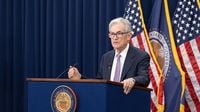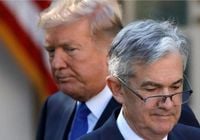In a decisive move amidst escalating trade tensions and political pressures, the Federal Reserve (Fed) has opted to maintain interest rates at their current level of 4.25% to 4.5% for the third consecutive time. This announcement was made by Jerome Powell, the Fed's chairman, on May 7, 2025, during a press conference following a two-day meeting of the Federal Open Market Committee (FOMC). Powell's decision underscores the Fed's commitment to its dual mandate of maximizing employment and stabilizing prices, despite mounting pressures from President Donald Trump to lower rates.
Powell emphasized the increasing uncertainty surrounding the economic outlook, particularly in light of Trump's recent announcement of tariffs on numerous trade partners five weeks prior to the meeting. He noted that the tariffs could exacerbate inflation and lead to a slowdown in economic growth, raising the specter of higher unemployment. "If the large tariff increases announced are maintained, they are likely to generate an increase in inflation, a slowdown in economic growth, and an increase in unemployment," Powell warned.
The Fed's decision to hold rates steady comes at a time when the U.S. economy is showing signs of resilience, with 177,000 jobs added in April, leaving the unemployment rate at a stable 4.2%. Furthermore, prices fell by 0.1% in March, resulting in an annual inflation rate of 2.4%. This data has provided the Fed with a cushion against the pressures to cut rates, which Trump has been vocal about on his social media platform, Truth Social.
Despite Trump's insistence that there is no inflation and his calls for immediate rate cuts, Powell reiterated that the Fed's decisions would be based solely on economic data and not on political pressures. "We will continue to do the same: use our tools to promote maximum employment and price stability for the benefit of the American people," Powell stated. He added that the Fed's approach would be one of caution, adopting a "wait and see" stance as the economic situation evolves.
The backdrop of this decision is a turbulent economic landscape, exacerbated by Trump's aggressive trade policies, which have led to significant fluctuations in the markets. In fact, Trump's administration saw a staggering loss of $6.5 trillion in market value within the first 100 days, marking the worst start for a presidency since Gerald Ford. This turmoil has raised concerns about potential recessionary pressures, particularly as the U.S. GDP contracted by 0.3% in the first quarter of 2025.
Moreover, the trade deficit surged by 14% to $140.5 billion in March, following the implementation of the tariffs. Analysts have pointed out that the uncertainty surrounding these tariffs could lead to a further increase in inflation, complicating the Fed's ability to manage monetary policy effectively.
Powell's independence has been a focal point of contention between him and Trump, who has publicly criticized the Fed chairman, referring to him as "Mr. Too Late" and expressing his desire for Powell to be more proactive in cutting rates. However, Powell has maintained that such pressures do not influence the Fed's operations. "The costs of doing nothing are low, so that is what we are doing," he remarked, indicating a cautious approach to monetary policy.
Looking ahead, the next FOMC meeting is scheduled for June 17 and 18, 2025, where further economic data will be evaluated, including employment figures for May and inflation statistics for April and May. These indicators will be crucial in determining whether the Fed will maintain its current stance or consider adjustments.
The upcoming negotiations between the U.S. and China in Switzerland, set for this Saturday, will also be pivotal in shaping the economic landscape. Both nations are under pressure to resolve their trade disputes, which have significant implications for global markets and the U.S. economy.
In summary, the Federal Reserve's decision to hold interest rates steady reflects a commitment to maintaining economic stability amidst political pressures and trade uncertainties. Powell's focus on data-driven decision-making underscores the Fed's independence and its role in navigating the complexities of the current economic environment. As the situation evolves, all eyes will be on the Fed's next steps and the potential impact of ongoing trade negotiations.






